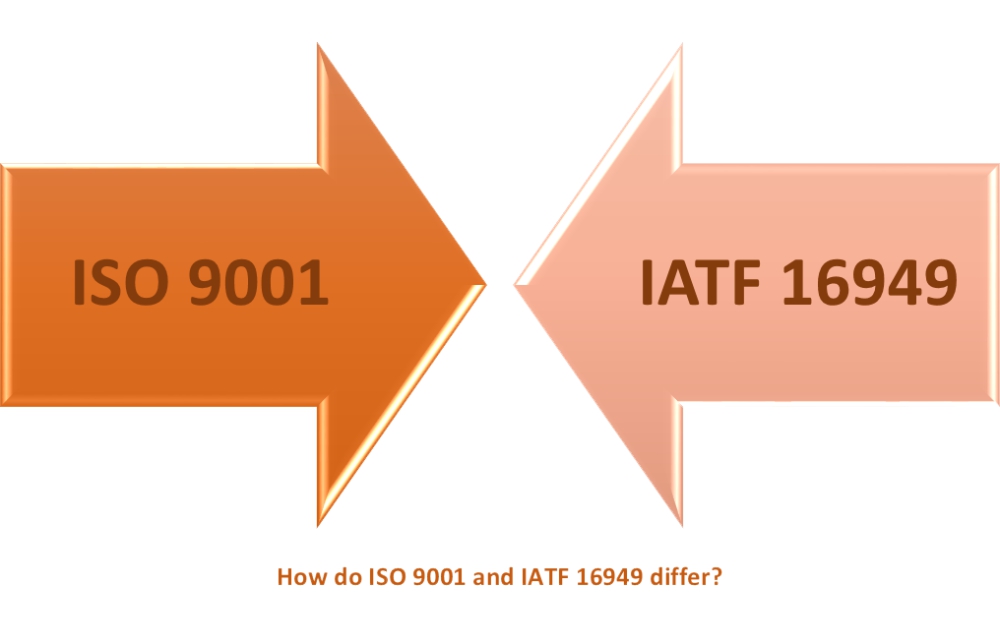 Alexandru Tudose
Alexandru Tudose
November 19, 2019
ISO 9001 is a general standard, applicable for all industries/sectors, from agriculture to manufacturing, and it is maintained by ISO. When talking about IATF 16949, the situation is completely different: this standard is maintained by the International Automotive Task Force, including membership from Chrysler, Ford Motor Company, General Motors Corp, PSA Peugeot Citroën and Renault, and other contributors, being specifically applicable for automotive parts producers.
But even with this segregation, IATF 16949 is, in a way, an extension of ISO 9001, being built on the same foundation. Therefore, a company in the automotive sector will have to implement both ISO 9001 requirements and IATF 16949-specific requirements (also including customer-specific requirements – specific requirements of car makers and other suppliers). In this article, you will learn more about the differences and connections between ISO 9001 and IATF 16949.

The IATF 16949 structure is similar to the ISO 9001 structure, being based on it.
Introduction. IATF 16949 starts with an introductory section, which includes general information about the history, goal, and remarks for certification. It continues with other general information regarding objectives, an explanation for how to understand the requirements, principles of quality management, the process approach, the Plan-Do-Check-Act (PDCA) cycle, risk-based thinking, and the relationship with other management system standards.
Scope. Then, the standard defines the scope: it is applicable for the sites where the customer-specific parts, service parts, and accessories are produced. In plain English, this means that it is possible to certify only those sites that produce parts for car assembly and service parts – not aftermarket parts!
This means that your company has to be an automotive parts producer; the support locations cannot get an individual IATF certification.
For more about CSR, read the article How to satisfy customer specific requirements when implementing IATF 16949.
Terms and definitions. Section 3 defines specific terms used in the automotive industry. You will need to read it carefully, because you will need to use a common language with your customer(s) and the certification body.
Context of the organization. Like ISO 9001, the standard continues with Context of the organization. This section 4 of IATF 16949 requires the organization to define remote locations with supporting functions. For example, if I work in a site that is part of a multinational company, perhaps HR-related activities are being performed at the headquarters. This is a support function that occurs in a remote location. By taking into consideration the requirements related to product safety and conformance, we have to establish specific processes.
Leadership. Section 5 requires the implementation of a corporate responsibility policy, the analysis of process effectiveness and efficiency, and the definition of process owners who need to be competent in managing identified processes for which they are accountable. At the end of this section, IATF 16949 requires the organization to nominate employees with responsibility and authority regarding the need to satisfy customer requirements.
Risks. In section 6, IATF 16949 adds specific requirements regarding analysis of sources of risk like scrap, field returns, and development of contingency plans. All of this is necessary to ensure the accomplishment of quality objectives (requested by customers).
Resources. In section 7, we are asked to plan our layouts by using a lean approach and to use measurement systems analysis methods to assess such systems, with specific requirements for internal and external laboratories. Also, we have to take care of calibration of inspection and testing equipment, training (especially on-the-job training) and employees’ empowerment and awareness-specific requirements. Last but not least, we have a special requirement regarding QMS documentation – not the same as ISO 9001, which allows us to structure our documentation as we choose; here we need to document a Quality Manual and a specific matrix for IATF 16949 requirements vs. established processes. The last requirement regarding control of engineering specifications defines the link to automotive industry-specific processes (practices), such as planning and controlling new product development and changes in products and processes triggered by changes of such specifications.
Learn more about documentation in the article How to structure IATF 16949:2016 documentation.
Operations. Next, section 8 comes with the majority of specific requirements, and requires the organization to apply specific automotive industry methods, starting from product development up to managing the production in the serial phase (mass production), i.e., what inputs we have to use for product design, management of special characteristics, and manufacturing process design. Also, we have to establish processes to monitor and report the development phases, including the link to management review, establishing a project team, performing product and process validation, controlling suppliers’ processes (including second-party audits), development and utilization of control plans, implementation of total productive maintenance, and controlling the changes (product and process, as applicable) during the serial phase.
Here we have specific requirements regarding maintenance and the utilization of enterprise resources planners that we have to consider, too.
Performance evaluation. Next, section 9 requires us to monitor and measure the manufacturing process, including the assessment of process capability, identification and application of statistical methods, monitoring of customer satisfaction by using specific methods, actions prioritization, and internal audit. We need to establish an audit program based on a three-year cycle and, by using it, to audit the system (QMS), the manufacturing process, and the delivered products. Also, here we will find specific requirements regarding management review.
Improvement. Section 10 comes with the main specific requirement: to establish a process for continual improvement and to use specific problem-solving methods (in the automotive industry, the 8D method is mainly used) and error-proofing systems. Also, we have to establish a warranty management system – a system that controls warranty claims issued by customers. For more about continual improvement, read the article Using Corrective Actions to Drive Continual Improvement in IATF 16949.
At the end, we will find annexes containing supplementary explanations – clarifications of terms, requirements, and control plan structure.
To summarize, compared to the ISO 9001 requirements, IATF 16949 includes specific requirements for the automotive industry, and additional customer-specific requirements that have to be implemented, too. In fact, for most of the ISO 9001 requirements, IATF 16949 adds more requirements to reinforce the control of their application. There are also SIs – sanctions interpretations published by IATF 16949, which, in several cases, override the requirements, and you need to do updates periodically.
Note at the end: consider applying good practices such as change control and product and process validation even if you are not an automotive company. Such practices were developed over decades based on industrial experiences and studies and were proven to provide good results.
To see how these requirements are reflected in writing policies and procedures, download this free white paper: Checklist of Mandatory Documentation Required by IATF 16949:2016.